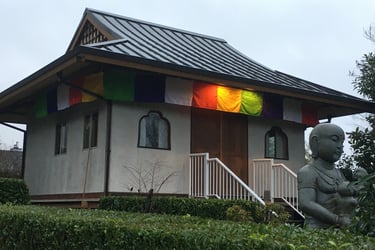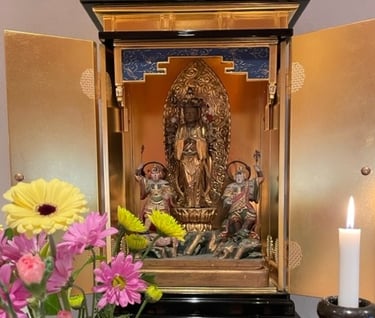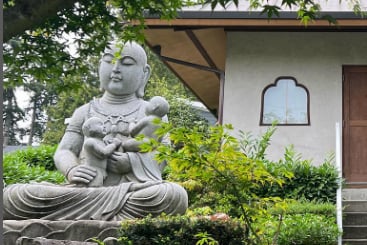

The Kannon Hall (Kannon Dō)
観音堂
This small structure was built in 2003 to house a statue of the bodhisattva Kannon which was given to Tōzenji by Yōkokuji (楊谷寺), a very old temple in the hills southwest of Kyoto. The Kannon-dō also functions as a resting place for the ashes of the departed.
Of all the bodhisattvas of East Asian Buddhism, Kannon is probably the most popular. Though it would be incorrect to refer to her as a deity, she is approached as one by the millions who turn to her for protection from harm, the fulfillment of various wishes, and whatever help may be sought from a higher power. But as a bodhisattva, Kannon is determined to help relieve us of the suffering which comes from ignorance, the ignorance which Buddhism considers to be the root of all suffering. To do so she will use all sorts of unexpected means. Like a mother who devises ways to help her young children develop in spite of their selfish demands, the bodhisattva constantly exerts herself to bring us onto the path to enlightenment. This is the “Great Compassion” of Mahayana Buddhism.
The Kannon of the shrine is a copy of a very famous statue called the “Yanagi-dani Kannon,” (Willow Valley Kannon 柳谷観音) which resides at the above mentioned Yōkuji. This temple was built in 806 by the priest Enchin (延鎮), who had a dream in which the bodhisattva told him that if he went to the hills to the west of Kyoto he would find Kannon in person. Thus directed, Enchin traveled to a valley thickly grown with willows and found the bodhisattva in the eleven-faced, thousand-armed, thousand-eyed form standing on a rock. He soon built a temple to venerate this bodhisattva but his duties as abbot of Kiyomizu Temple in Kyoto called him back to the city.
At that time Kūkai (空海 Kōbō Daishi) became second abbot of Yōkokuji. Tōzenji’s Kannon is a type of “clone statue” (bunshin 分身). In other words it is a replica of the Yanagi-dani Kannon, but it is considered to be the same in substance as the original, which means it possesses the same powers.
At Yōkokuji there is an old belief that this Kannon is especially effective in helping people with eye problems. This idea has its origins partially in a story concerning Kūkai when he was abbot of the temple. One day he spotted a monkey with her child in the grotto next to the main hall. The mother monkey was intently washing the baby’s closed eyes with water that had collected in the grotto. Taking pity on the baby monkey, whose eyes were not functioning properly, Kūkai spent the next seventeen days conducting a ritual for its sake. On the seventeenth day the monkey suddenly opened its eyes, and with sight fully restored, ran happily back up the mountain.




Bodhisattva Jizō
地蔵
As we approach the shrine we first pass a large granite statue of the bodhisattva Jizō (地蔵, Skt. Ksitigarbha) on the left side of the path. Originally this bodhisattva was conceived of as the one who would help people in this world between the time of the death of Shākyamuni and the time when the bodhisattva Miroku (弥勒 Skt. Maitreya) attains full enlightenment. Later he became popular as the protector of children, travelers, fire fighters and those in the hell realms.
In Japan one finds stone statues of Jizō everywhere. Most commonly he is depicted as a monk, standing with a staff in one hand and the wish-fulfilling gem in the other, but in this case we have a modern representation of him as “Mother and Child Jizō” (boshi jizō 母子地蔵).
